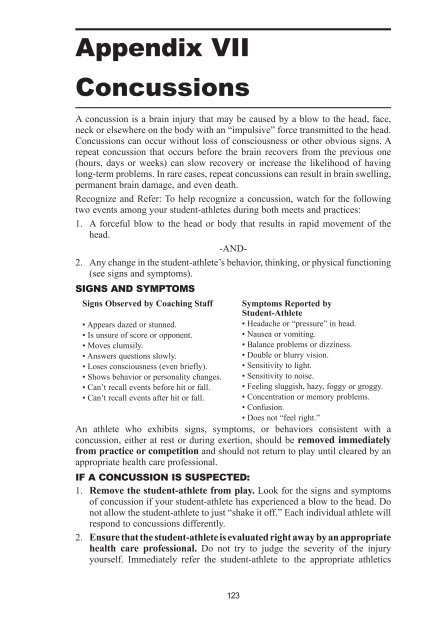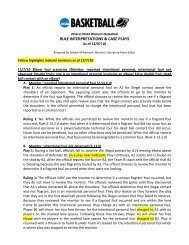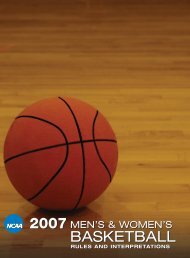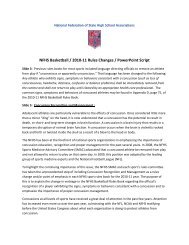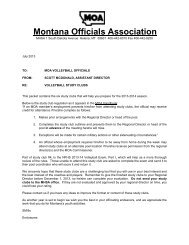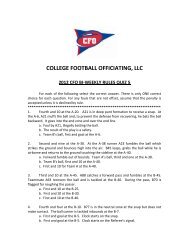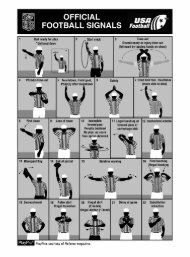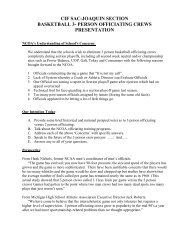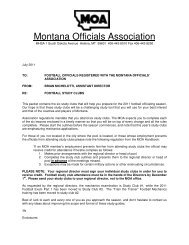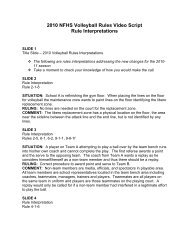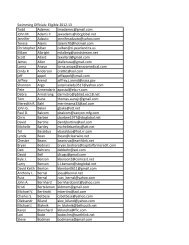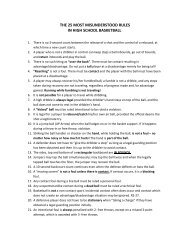2011-12 AND 2012-13 MEN'S AND WOMEN'S RULES - NAIA
2011-12 AND 2012-13 MEN'S AND WOMEN'S RULES - NAIA
2011-12 AND 2012-13 MEN'S AND WOMEN'S RULES - NAIA
You also want an ePaper? Increase the reach of your titles
YUMPU automatically turns print PDFs into web optimized ePapers that Google loves.
Appendix VII<br />
Concussions<br />
A concussion is a brain injury that may be caused by a blow to the head, face,<br />
neck or elsewhere on the body with an “impulsive” force transmitted to the head.<br />
Concussions can occur without loss of consciousness or other obvious signs. A<br />
repeat concussion that occurs before the brain recovers from the previous one<br />
(hours, days or weeks) can slow recovery or increase the likelihood of having<br />
long-term problems. In rare cases, repeat concussions can result in brain swelling,<br />
permanent brain damage, and even death.<br />
Recognize and Refer: To help recognize a concussion, watch for the following<br />
two events among your student-athletes during both meets and practices:<br />
1. A forceful blow to the head or body that results in rapid movement of the<br />
head.<br />
-<strong>AND</strong>-<br />
2. Any change in the student-athlete’s behavior, thinking, or physical functioning<br />
(see signs and symptoms).<br />
SIGNS <strong>AND</strong> SYMPTOMS<br />
Signs Observed by Coaching Staff<br />
• Appears dazed or stunned.<br />
• Is unsure of score or opponent.<br />
• Moves clumsily.<br />
• Answers questions slowly.<br />
• Loses consciousness (even briefly).<br />
• Shows behavior or personality changes.<br />
• Can’t recall events before hit or fall.<br />
• Can’t recall events after hit or fall.<br />
Symptoms Reported by<br />
Student-Athlete<br />
• Headache or “pressure” in head.<br />
• Nausea or vomiting.<br />
• Balance problems or dizziness.<br />
• Double or blurry vision.<br />
• Sensitivity to light.<br />
• Sensitivity to noise.<br />
• Feeling sluggish, hazy, foggy or groggy.<br />
• Concentration or memory problems.<br />
• Confusion.<br />
• Does not “feel right.”<br />
An athlete who exhibits signs, symptoms, or behaviors consistent with a<br />
concussion, either at rest or during exertion, should be removed immediately<br />
from practice or competition and should not return to play until cleared by an<br />
appropriate health care professional.<br />
IF A CONCUSSION IS SUSPECTED:<br />
1. Remove the student-athlete from play. Look for the signs and symptoms<br />
of concussion if your student-athlete has experienced a blow to the head. Do<br />
not allow the student-athlete to just “shake it off.” Each individual athlete will<br />
respond to concussions differently.<br />
2. Ensure that the student-athlete is evaluated right away by an appropriate<br />
health care professional. Do not try to judge the severity of the injury<br />
yourself. Immediately refer the student-athlete to the appropriate athletics<br />
<strong>12</strong>3


